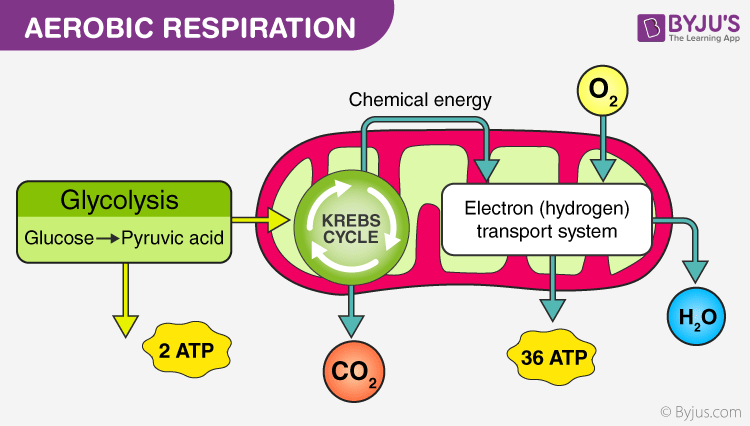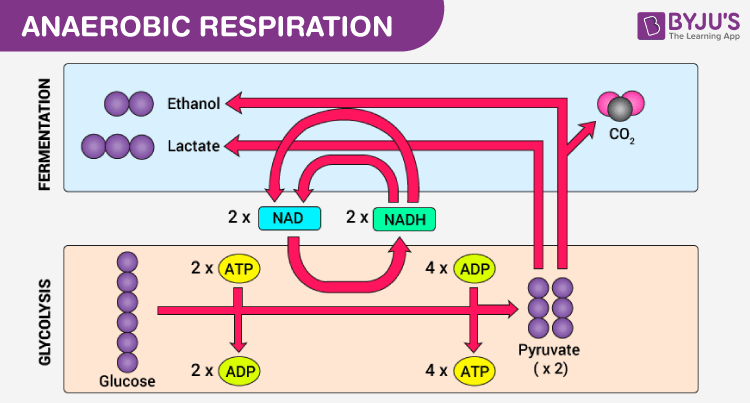Cellular respiration is a process that takes place inside the cells where energy is released by the breakdown of glucose molecules. The process can be conveniently divided into two categories based on the usage of oxygen, namely aerobic and anaerobic respiration.
Table of Contents
Let us have a look at the major difference between aerobic and anaerobic respiration.

Difference Between Aerobic and Anaerobic Respiration
The primary difference between aerobic and anaerobic respiration is the presence or absence of oxygen during the processes. More detailed differences between the two are as follows:
| Aerobic Respiration | Anaerobic Respiration |
| Oxygen is present when this form of respiration takes place. | Oxygen is absent when this form of respiration takes place. |
| Gases are exchanged in this form of respiration. | Gases are not exchanged in this form of respiration. |
| It can be found in the cytoplasm and the mitochondria. | It can be found only in the cytoplasm. |
| Glucose breaks down into carbon dioxide and water. | Glucose breaks down into ethyl alcohol, carbon dioxide and energy. |
| All higher organisms such as mammals have this type of respiration. | Lower organisms such as bacteria and yeast use this type. In other organisms, it occurs during heavy activities. |
However, it is a misconception that humans and other multicellular organisms use only aerobic respiration. This is disproven by the fact that our muscles, during vigorous exercises, undergo anaerobic respiration, where lactic acid is produced as the waste byproduct instead of carbon dioxide.
Also Read: Difference between Glycolysis and Krebs Cycle
Aerobic and Anaerobic Respiration
What is Aerobic Respiration?

As already stated, cellular respiration can be of two types: aerobic and anaerobic. Aerobic means “with air”. Therefore, aerobic respiration is the process of cellular respiration that uses oxygen to produce energy from food. This type of respiration is common in most plants and animals, including humans, birds and other mammals.
Discover: How Plants Respire
While breathing, we inhale air that contains oxygen and we exhale air rich in carbon dioxide. As we breathe in, the oxygen-rich air is transported to all the parts of our body and ultimately to each cell. Inside the cell, the food, which contains glucose, is broken down into carbon dioxide and water with the help of oxygen. The process of breaking down the food particles releases energy, which is then utilized by our body. The energy released via aerobic respiration helps plants and animals, including us, grow.
The process can be simply explained with the help of the following equation:
Glucose + Oxygen → Carbon dioxide + Water + Energy
Aerobic respiration is a continuous process and it happens all the time inside the cells of animals and plants.
What is Anaerobic Respiration?

Anaerobic means “without air”. Therefore, this type of cellular respiration does not use oxygen to produce energy. Sometimes there is not enough oxygen around for some organisms to respire, but they still need the energy to survive. Due to lack of oxygen, they carry out respiration in the absence of oxygen to produce the energy they require, which is referred to as anaerobic respiration. Anaerobic respiration usually occurs in lower plants and microorganisms. In the absence of oxygen, the glucose derived from food is broken down into alcohol and carbon dioxide along with the production of energy.
Further Reading: Fermentation: Anaerobic Respiration
Glucose → Alcohol + Carbon dioxide + Energy
Anaerobic respiration is also used by multi-cellular organisms, like us, as a temporary response to oxygen-less conditions. During heavy or intensive exercise such as running, sprinting, cycling or weight lifting, our body demands high energy. As the supply of oxygen is limited, the muscle cells inside our body resort to anaerobic respiration to fulfil the energy demand.
How do you feel when you exercise too much? Have you ever wondered why you get those muscle cramps when you run very fast? Anaerobic respiration is the culprit to be blamed. Cramps occur when muscle cells respire anaerobically. Partial breakdown of glucose, due to lack of oxygen, produces lactic acid and the accumulation of lactic acid causes muscle cramps. That is why a hot shower after heavy sports relieves the cramps as it improves blood circulation in the body, which in turn enhances the supply of oxygen to the cells.
Glucose → Lactic acid + Energy
Anaerobic respiration produces a relatively lesser amount of energy as compared to aerobic respiration, as glucose is not completely broken down in the absence of oxygen.
In-Depth Reading: Cellular Respiration: Aerobic Vs Anaerobic
Conclusion
The fundamental difference between aerobic and anaerobic respiration is the usage of oxygen in the process of cellular respiration. Aerobic respiration, as the name suggests, is the process of producing the energy required by cells using oxygen. The by-product of this process produces carbon dioxide along with ATP – the energy currency of the cells. Anaerobic respiration is similar to aerobic respiration, except, the process happens without the presence of oxygen. Consequently, the by-products of this process are lactic acid and ATP.
Contrary to popular belief, multicellular organisms, including humans, use anaerobic respiration to produce energy, though this only happens when the muscles do not get adequate oxygen due to extremely vigorous activities.
To learn more about aerobic and anaerobic respiration, or any other related topic, explore BYJU’S Biology.
Further Reading:

Frequently Asked Questions
What is Respiration?
Respiration is a biochemical process which is common in all living organisms. In this process, there is the movement of air in and out of the lungs.
List out the different types of Respiration?
There are two types of Respiration:
- Aerobic Respiration — Takes place in the presence of oxygen.
- Anaerobic Respiration –Takes place in the absence of oxygen.
What is the overall equation of aerobic cellular respiration?
The equation for aerobic cellular respiration is:
C6H12O6 + 6O2 ————–> 6CO2 + 6H2O + ATP
List out the different types of Anaerobic Respiration?
There are two main types of anaerobic respiration:
- Alcoholic fermentation
- Lactic acid fermentation.
Name the different stages of Aerobic Respiration?
The three stages of Aerobic Cellular Respiration are
- Glycolysis
- The Krebs cycle
- Oxidative phosphorylation.
Where does aerobic and anaerobic respiration occur in the cell?
In the cell, Aerobic respiration occurs within the mitochondria, and the anaerobic respiration occurs within the cytoplasm of a cell.


it is very helpful
Yes 👍 its very helpful
It is very help full because of 3d animation technology
what is the equation of forming of lactic acid during heavy workout?
It’s interesting
It was really helpful
This was much helpful
Thank you teachers! Very useful!
Its very necessary for us thank you sir
Very helpful video
This was very helpful about Aerobic and Anaerobic Respiration
Thank You BYJU’S for this
Very helpful about my exams.
👍👍🙏🙏☺️☺️😊😊
Hi!!
Answers were really really really really helpful
Tysm to Byjus 😊
Now I am fully prepared for the test too ☺️☺️
Sufficient study material and make great understanding for concepts 👍🙂